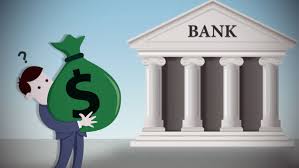Over the years, banks experienced a metamorphosis from simple corner branches offering savings, checking, and basic bank loans, to mega financial entities offering investment products, mortgages, specialized lines of credit, investment banking, and private banking. All of these additional services along with the regular “fees” banks charge is how they earn money.
The dismantling of the depression era regulation, the Glass-Steagall Act, also known as the Banking Act of 1933, allowed banks, insurance companies, and investment banks the ability to enter into multiple business functions. Some economists believe that the loosening of these regulations, along with the tightening of the Community Reinvestment Act (CRA) that started in the mid 1990s may have led to the financial crisis of September 2008.
For years banks basically made money from the interest earned on their loans and mortgages. This interest earned by banks is known as net interest margin, thus greater interest rates essentially earned larger net interest margins. This formula was fine for years until rates started to drop. As rates dropped, banks were able to earn less of a margin. That margin is the difference between what banks pay the depositors and federal reserve bank to borrow funds versus what they lend it out for to both retail and institutional customers.

And yes, when you are a depositor to a bank you are lending your money to the bank, so they can re-lend it out at a higher rate. The difficult part of banking is to get enough people to “lend the bank money” through deposits. Having your deposits at the bank is their life blood. Incidentally, that is one way for a bank to fail - if most customers withdrew all their money at a time when the bank could not call in enough loans to meet the needs of the depositors. Historically this is known as a “run on the bank,” which is what happened in the early 1930’s, causing thousands of banks to fail.
Credit Card Debt On The Rise
An example of how banks make moneys the use of credit cards. U.S. banks have ramped up lending to consumers through credit cards at the fastest pace since 2007. The industry has accumulated an additional $18 billion of credit card loans and other types of revolving credit in the past three months.
Data released by the Federal Reserve shows that the U.S. banking industry has seen credit card and other revolving loans rise at a annual rate of 7.6% in the second quarter of 2016, to $685 billion. The credit card business remains among the most profitable in banking as banks can charge much higher interest rates than other loan types, with average credit card rates between 12% and 14%.
Taking the lower rate of 12% with the typical CD rate of 1.0%, that gives the bank a net interest margin of 11.0% on that book of business. However for most banks, (small community banks) credit cards are a very small percentage of their business. To the larger banks, like Capital One and many others, credit cards lending is a much larger part of their business model. Along with credit card lending the default rate is much higher too, which lowers profits.
As credit card debt levels have risen, so have reserves for losses as banks anticipate delinquencies to rise. According to Federal Reserve data, within the past year U.S. banks have piled on about $54 billion worth of loans to consumers through credit cards,. Financially savvy consumers that pay their balances down each month avoid hefty interest charges, but those that don’t, known as “revolvers,” pay average rates of between 12% to 14% and significantly more, as much as 30%, if they are considered higher risk borrowers.
Seven years since the recession ended, consumers who were hit hard during the financial crisis have found their credit scores improving. Bankers attribute a rise in credit card issuance to rising home prices and low unemployment. Banks are also lending more since one of the most important drivers of their profits are net interest margins, the difference between returns on assets and the cost of funds, which remain near their lowest levels in decades. The average credit limit per card for a subprime borrower is about $2,300, compared with about $11,500 for the safest customers.
How does this affect you personally? I would suggest monitoring your banking relationships regularly. Review the fees you pay, what rates you pay on credit cards, etc. Look for the low cost solutions. And above all GET OUT and STAY OUT OF DEBT! Don’t get sucked into the emotional feeling that you “need” something so badly that you will borrow for it (home excluded). The credit card offers are so enticing with all the points they give you back, etc.; these are bank promotions and marketing games. Just get out and stay out of debt. Period. Your real financial strength is not from your credit score - it is from your ability to stay out of debt.
Sources: Federal Reserve, FDIC, Office of the Comptroller of the Currency
REMEMBER:
"Gold is money, anything else is credit." - J.P. Morgan



